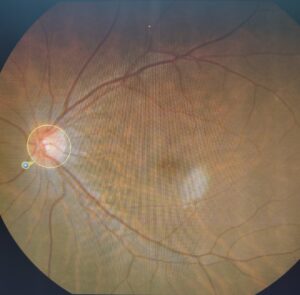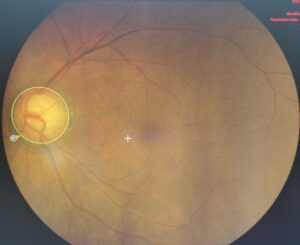Let’s shine a light on a serious eye condition that often flies under the radar: Glaucoma. Glaucoma is a silent thief of sight. Now, I know what you might be thinking – “Glaucoma? That sounds like something out of a sci-fi movie!” Well, it’s not as far-fetched as it sounds, and it’s essential to know about it because, hey, it could affect you or someone you care about.
So, what exactly is glaucoma?
In simple terms, it’s a group of eye conditions that damage the optic nerve, usually due to increased pressure within the eye. Think of it as a plumbing issue in your eye – when the drainage system gets clogged or doesn’t work correctly, pressure builds up, and that can lead to serious problems over time.

Normal optic disc

Optic disc of a glaucoma patient
Now, here’s the kicker – glaucoma often sneaks up on you without any noticeable symptoms in the early stages. That’s why it’s sometimes called the “silent thief of sight.” You could be going about your day, blissfully unaware that your vision is slowly being compromised by glaucoma.
How is Hippocrates related to Glaucoma?
Glaucoma is not a modern disease, it has actually been mentioned since 400B.C.E Hippocrates of ancient Greece and by Susruta of India. Yup, that’s right. Hippocrates actually named this condition “glaykoseis” which means glaucoma… Back in the day, treatments includes use of herb mixtures and compresses, but it gives varying result. As it turns out, Modern Science found that the herb thyme has the compound effective on reducing the eye pressure (please consult your eye specialist on the most effective treatments for glaucoma).
By mid of 1800s a new method of reducing pressure on the eye ball was found by Albrecht von Graefe, a German Opthalmologist. The procedure is called Sclerotomy, it involved using a sharp instrument to make a hole on the white part of the eye. Sounds brutal doesn’t it? Not only that, the procedure comes with complications such as bleeding or infection. Lucky for us, we live in an advanced technology era. By the end of the 1800s they’ve developed a less invasive technique that gave a significant advancement in glaucoma cases called iridectomy. It involves removing some parts of the Iris. Believe it or not, this technique is still being used until today.
In 1970s, the first topical drop for glaucoma was created to reduce pressure in the eye, it is still being used until now. Few combinations of eye drop will be prescribed to patients. The only issue that rises with usage of these eye drops is that most people tend to forget to use the eye drops. Yup, we forget. Now, our options are wider. You can even opt for Selective Laser Trabeculoplasty (a.k.a. SLT), time-release medications, or Minimally Invasive Glaucoma Surgery (a.k.a. MIGS).
What should YOU do?
There are ways to detect and manage glaucoma effectively. Regular eye check-ups are crucial, especially as you get older or if you have a family history of eye problems, or if you have had an injury, severe allergic reaction or infection on your eye. Our optometrists at a kedai cermin mata (spectacle shop) can measure your eye pressure, check the health of your optic nerve, and perform other tests to catch glaucoma early on.
Watch out for these symptoms of glaucoma:
- Gradual loss of peripheral vision leading to tunnel vision (advanced stages)
- Sensitivity to light
- Severe eye pain
- Headaches
- Nausea or vomiting
- Eye redness
- Gradual blurring of vision
Treatment for glaucoma typically involves eye drops to lower the pressure inside your eye, laser treatments, or surgery in more severe cases. The goal is to prevent further damage to your optic nerve and preserve your vision for the long haul.
So, what’s the bottom line? Glaucoma might not be making headlines, but it’s a serious eye condition that deserves our attention. Stay proactive about your eye health, get those regular check-ups at a kedai cermin mata, and remember – a little prevention today can save your vision tomorrow from glaucoma.

